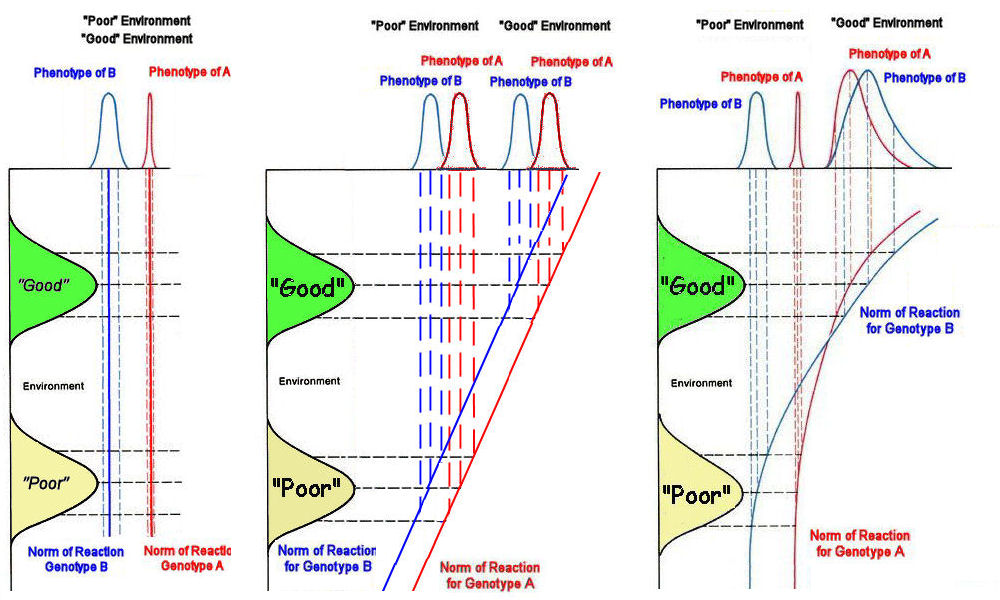
Genetics, Environment, &
The Norm of Reaction [ II ]
"Is
the difference
between
groups
genetic?"

Genetics, Environment, &
The Norm of Reaction [ II ]
"Is
the difference
between
groups
genetic?"
We defined the Norm of Reaction as a
curve that relates, for a given genotype, the contribution of environmental variation to observed phenotypic variation. The
norm of reaction curve can be thought of as a mirror that
reflects the environmental-effect curve into phenotypic space.
We showed how the shape of the curve affects the expression of a
single genotype in a single group or
population. We now ask, given two alternative genotypes,
does the norm of reaction explain observed phenotypic
differences between groups?
Consider two breeds of cattle, corresponding to genotypes A & B, evaluated for milk-fat production in "Good" and "Poor" environments (the group difference), under three forms of the Norm of Reaction curve.
[Left]
The norm of reaction for each
genotype is flat line,
and the two lines are offset.
Among cattle raised in either a nutrient-poor free-range
environment ("Poor" curve on the y-axis) or a nutrient-rich
feed-lot environment ("Good" curve), those with genotype
A always produce higher milk-fat (narrow red curve on
x-axis) than do those with genotype B (narrow blue
curve). The range of phenotypes for each breed is quite
small and largely independent of the environment. A conventional
Heritability study of
milk-fat production made in either environment will conclude
that genes have a strong influence on milk-fat production (high heritability). This
corresponds to a pattern in which the difference between breeds is "genetic", in the sense that it is
determined by and predictable from genotype, independent of
environment.
[Middle]
The norm of reaction for each genotypes is a sloped line, and the two
lines are offset with constant slope. Improvement of the
environment from "Poor" to "Good" results in a significant
increase in milk-fat quantity in both breeds. In either
environment, the performance of genotype A always exceeds that of genotype
B. However, the performance of genotype B in the "Good" environment exceeds that of genotype A in the "Poor" environment. Milk-fat
production still has high
heritability, but has a strong environmental component. Expectations of the
performance (phenotype) of either breed must take environment
into consideration.
[Right]
The norm of reaction for each genotype is a complex curve, and the
curves have different shapes. The two curves are essentially
flat and parallel in the "Poor" environment, and heritability
is high as in the first example. When the same two breeds are
raised in the "Good" environment, both show a marked
improvement in average milk-fat production, as in the second
example. However, cattle with genotype B
now on average produce richer milk than those with
genotype A (mean of the
blue curve shifted to the right of the red curve), the
reverse of the previous situation. As the norm of reaction
becomes steeper, both breeds also show a wider range of milk fat
production (broad blue and red curves), depending on the exact
environmental conditions. A study of heritability in
the "Good" environment will conclude that the
difference in genotypes has relatively low influence on milk-fat
production (low heritability),
which is mostly a consequence of environmental variation.
Thus the relative
importance of "Genetics" and "Environment" cannot
be expressed as a unitary Heritability
coefficient, which may vary greatly depending on the
environment in which the genes are expressed. The conventional
quantitative genetic study of heritability measured for a single population within a
single environment cannot accurately
estimate the Norm of Reaction between
groups and environments, and may not predict phenotypic
response in a different environment.